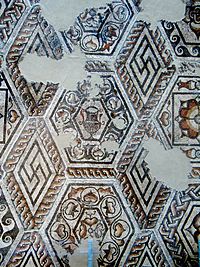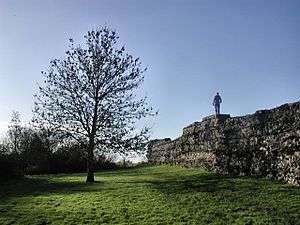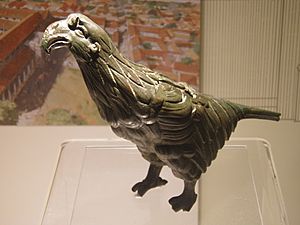Calleva Atrebatum facts for kids
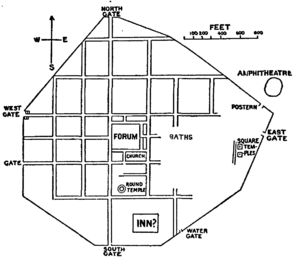
Site plan of Calleva Atrebatum
|
|
| Alternative name | Silchester Roman Town |
|---|---|
| Location | Silchester, Hampshire, England |
| Region | Britannia |
| Coordinates | 51°21′26″N 1°4′57″W / 51.35722°N 1.08250°W |
| Type | Settlement |
| Area | Approximately 40 ha (99 acres) |
| History | |
| Builder | Atrebates tribe |
| Founded | Late 1st century BC |
| Abandoned | 5th to 7th century AD |
| Periods | Iron Age to Roman Empire |
| Site notes | |
| Management | English Heritage |
| Website | Silchester Roman City Walls and Amphitheatre |
| OS grid reference: SU639624 | |
Calleva Atrebatum was an important ancient town in what is now England. Its name means "Calleva of the Atrebates". It started as an Iron Age settlement, which was the main town for the Atrebates tribe. Later, it became a busy town in the Roman province of Britannia. Today, you can find its ruins near the village of Silchester in Hampshire. The old town walls are still visible, and a small church stands inside them.
Contents
Discovering Calleva Atrebatum
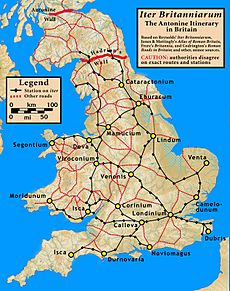
Calleva Atrebatum is special because the Roman town was built right on top of the earlier Iron Age settlement. This was unusual for tribal capitals in Britain.
Celtic Beginnings
The name "Calleva Atrebatum" comes from the Celtic language. It means 'woody place'. The area around the settlement had thick forests. These forests provided wood for building and for fuel. Because of its good location, Calleva was a busy trading hub. People traded goods within Britain and with other civilizations. Some goods even came from across the English Channel and as far away as the Mediterranean Sea.
Life in the Iron Age
Archaeologists have found many clues about the Iron Age settlement at Silchester. Coins found here show that Commius, a king of the Atrebates, made this his home. He even had his own mint here to make coins. The Iron Age town was built on a gravel plateau. Around 1 AD, a large defensive earthwork was built. It enclosed an area of about 32 hectares (79 acres). Even bigger earthworks were built around the wider area for protection.
Digs have shown that people lived here in the Late Iron Age. They built roundhouses and dug wells. They also had paved streets and fenced areas. Fancy pottery, large jars, and metal brooches were found. These items show that important people lived in Calleva. They also ate well, with evidence of oyster shells, and food that came in jars, like olive oil and wine.
More recent digs have found a large rectangular hall from around 25 BC. They also found new lanes and property lines from around 10 AD. Studies of ancient plants show that people were eating celery, coriander, and olives. This was happening even before the Romans arrived.
The Roman Era
After the Roman conquest of Britain in 43 AD, Calleva Atrebatum grew into a Roman town.
The Roman town was a bit bigger, covering about 40 hectares (100 acres). It was laid out with a clear grid pattern of streets. The town had many public buildings and was very successful. It continued to thrive until the early Anglo-Saxon period.
A large guesthouse, called a mansio, was located near the South Gate. There was also a possible water shrine, or nymphaeum, near the amphitheater.
Calleva was a very important crossroads for Roman roads. The Devil's Highway connected it to Londinium, the Roman capital. From Calleva, roads led to other major Roman towns. These included Aquae Sulis (Bath), Glevum (Gloucester), and Sorviodunum (Old Sarum near Salisbury).
You can still see the old earthworks and ruined walls today. The remains of the amphitheatre are also very clear. This was added around 70-80 AD and was outside the city walls. The area inside the walls is mostly farmland now. At its busiest, the Roman amphitheater could hold about 7,000 people. They watched exciting shows like bear fighting and gladiator contests. Around the 3rd century, the amphitheater was improved. New entrances were added, and it was made more oval-shaped. Even after the Romans left, local people continued to use it.
In the southeast of the city were the "thermal baths." These were some of the first stone buildings, built around 50 AD. The baths were later changed to fit the new street layout. They had a large open area for exercise and several bath rooms. Later, the baths were divided, probably so men and women could bathe separately.
A spring flows from inside the walls, near the old baths. This spring helped Calleva grow. The town may have had nearly 10,000 people by the 3rd or 4th century.
After the Romans Left
After the Romans left Britain, people still lived in Calleva Atrebatum. However, the town slowly started to decline. Important buildings were still used around 400-430 AD. But after 450 AD, there is much less evidence of people living there. Unlike most Roman towns in Britain, Calleva did not survive. It disappeared during the Middle Ages.
Some historians think the Saxons avoided Calleva after it was abandoned. They preferred their own towns like Winchester and Dorchester. For a long time, Calleva was mostly left alone. This means its ruins have been well preserved.
Daily Life and Culture
Farming and Food
Studies of ancient plant remains show how people farmed and what they ate. They managed hay meadows and used resources from the heathlands. The most common crops were wheat and barley. People also ate many fruits like apples, figs, and grapes. They used flavorings like celery and dill. Many homes had their own grinding stones to make flour. Cattle, sheep, goats, and pigs were the main sources of meat.
The land around Calleva was good for farming. It was located between chalk hills and the Thames Valley. The soil was well-drained, which was good for growing crops.
Religion and Beliefs
People in Calleva had different religious practices. A possible early church was found in the town. Its design is similar to early churches in the Roman Empire. There was also a Romano-Celtic temple. An inscription there shows it was dedicated by a group of travelers. Three more Romano-Celtic temples were found near the east gate. These were built in the mid-1st century AD. A stone head of the god Serapis was also found.
Protecting the City
The town's defense system was built in two stages. The first walls were built around 200 AD. You can still see parts of these stone and tile walls. In 270 AD, the defenses were made even stronger with a larger stone wall. This was probably to protect against more Saxon raids. The walls helped protect the town from attacks and allowed them to control who came in and out.
Economy and Trade
Making Things
People in Calleva were skilled craftspeople. They worked with bone and antler. They also worked with copper and made leather goods. Even imported sharpening stones were reused.
Building Materials
Many buildings in Calleva were made of timber because there was a lot of wood nearby. There were also tile kilns in the area. Some tiles even had the name of Emperor Nero stamped on them.
Goods from Far Away
Many different items were brought to Silchester from across the Roman Empire. These included an ivory razor handle and a figure of the god Harpocrates. Pottery from places like Lezoux in France and the Rhineland was also imported.
Archaeology and Discoveries
The first major excavations at Calleva Atrebatum began in the late 1800s. The Reverend James Joyce was a key figure. In 1866, he found a bronze eagle, now known as 'The Silchester Eagle'. It is now in the Museum of Reading. This eagle might have been part of a statue of the god Jupiter.
The Duke of Wellington, who owned the land, started the first big digs. Reverend James Joyce recorded everything they found. Their goal was to uncover the complete plan of the Roman town. For many years, not much more was learned. But in 1961, new digs found that most of the early Christian Church had already been excavated. They found the foundations of stone buildings by digging trenches. At the time, they didn't fully understand the timber buildings, which were very common.
Since the 1970s, Michael Fulford and the University of Reading have led many important excavations. They have dug at the town walls, the amphitheatre, and the forum basilica. These digs have found amazing things from both the Iron Age and early Roman times.
From 1997 to 2014, Reading University focused on a specific area called Insula IX. They found out a lot about the Late Roman, Mid Roman, and Late Iron Age periods. In 2013, they started digging in Insula III, looking at a building that earlier excavators thought was a bathhouse. Since 2018, the University of Reading has been re-exploring the public bathhouse ruins. They are looking for things that earlier archaeologists might have missed.
Visiting Calleva
Today, the site of Calleva is mostly owned by Hampshire County Council. It is managed by English Heritage. You can visit the site for free during daylight hours, seven days a week. You can walk around the entire circumference of the walls and explore the amphitheater. The land inside the walls is mostly farmland. You can't walk everywhere, except for the church and a single path.
The Museum of Reading in Reading Town Hall has a special gallery. It is dedicated to Calleva and displays many amazing finds from the excavations.



